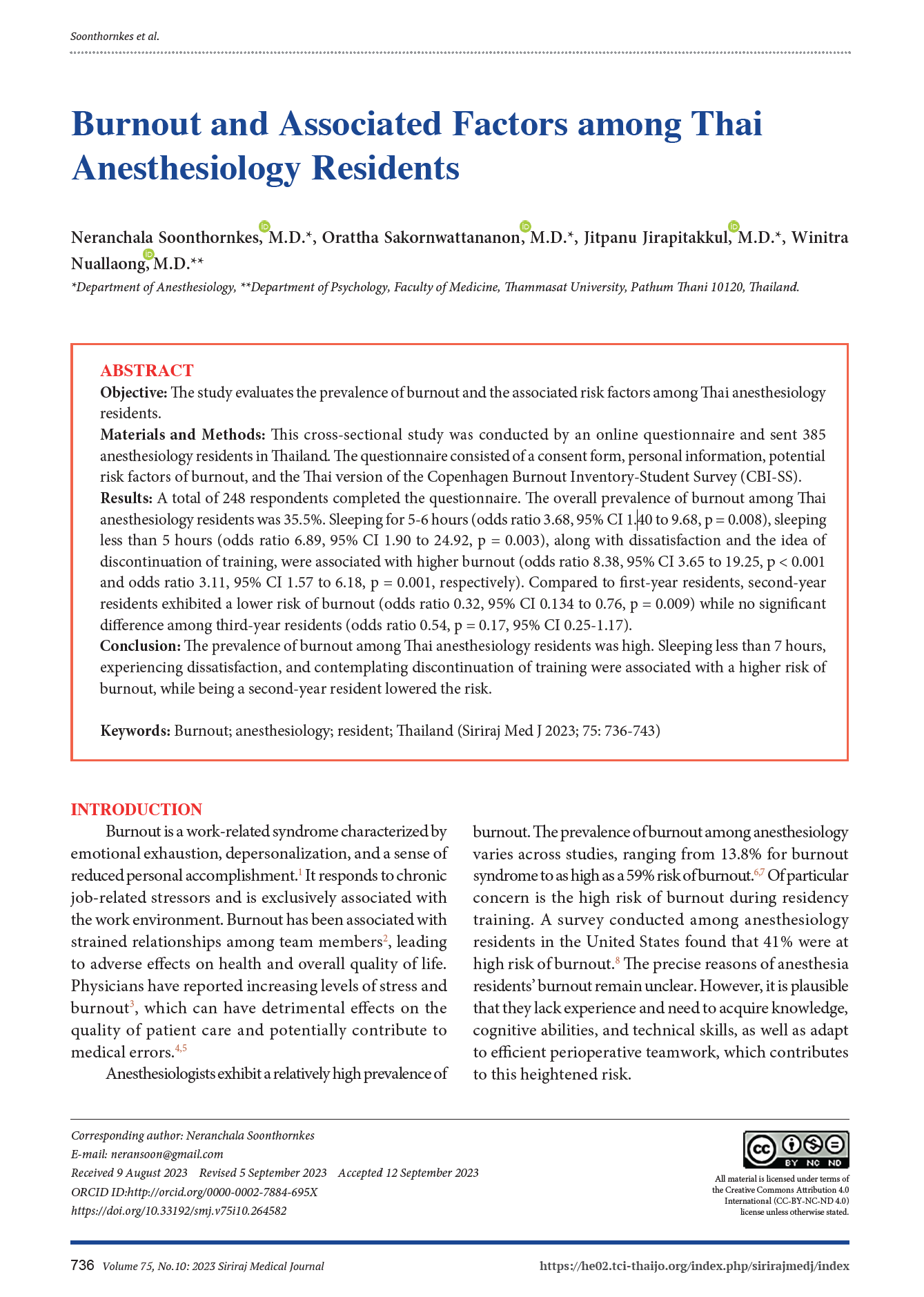Burnout and Associated Factors among Thai Anesthesiology Residents
DOI:
https://doi.org/10.33192/smj.v75i10.264582Keywords:
Burnout, anesthesiology, resident, ThailandAbstract
Objective: The study evaluates the prevalence of burnout and the associated risk factors among Thai anesthesiology residents.
Materials and Methods: This cross-sectional study was conducted by an online questionnaire and sent 385 anesthesiology residents in Thailand. The questionnaire consisted of a consent form, personal information, potential risk factors of burnout, and the Thai version of the Copenhagen Burnout Inventory-Student Survey (CBI-SS).
Results: A total of 248 respondents completed the questionnaire. The overall prevalence of burnout among Thai anesthesiology residents was 35.5%. Sleeping for 5-6 hours (odds ratio 3.68, 95% CI 1.40 to 9.68, p = 0.008), sleeping less than 5 hours (odds ratio 6.89, 95% CI 1.90 to 24.92, p = 0.003), along with dissatisfaction and the idea of discontinuation of training, were associated with higher burnout (odds ratio 8.38, 95% CI 3.65 to 19.25, p < 0.001 and odds ratio 3.11, 95% CI 1.57 to 6.18, p = 0.001, respectively). Compared to first-year residents, second-year residents exhibited a lower risk of burnout (odds ratio 0.32, 95% CI 0.134 to 0.76, p = 0.009) while no significant difference among third-year residents (odds ratio 0.54, p = 0.17, 95% CI 0.25-1.17).
Conclusion: The prevalence of burnout among Thai anesthesiology residents was high. Sleeping less than 7 hours, experiencing dissatisfaction, and contemplating discontinuation of training were associated with a higher risk of burnout, while being a second-year resident lowered the risk.
References
Maslach C, Jackson S E, Leiter M. Maslach Burnout Inventory. In book: Evaluating Stress: A Book of Resources Publisher: The Scarecrow Press, Editors. C. P. Zalaquett, R. J. Wood 1, January 1997. p.191-218
Devi S. Doctors in distress. Lancet. 2011;377(9764):454-5.
Shanafelt TD, Boone S, Tan L, Dyrbye LN, Sotile W, Satele D, West CP, Sloan J, Oreskovich MR. Burnout and satisfaction with work-life balance among US physicians relative to the general US population. Arch Intern Med. 2012;172(18):1377-85.
Shanafelt TD, Balch CM, Bechamps G, Russell T, Dyrbye L, Satele D, Collicott P, Novotny PJ, Sloan J, Freischlag J. Burnout and medical errors among American surgeons. Ann Surg. 2010;251(6):995-1000.
Firth-Cozens J, Greenhalgh J. Doctors' perceptions of the links between stress and lowered clinical care. Soc Sci Med. 1997;44(7):1017-22.
Sanfilippo F, Noto A, Foresta G, Santonocito C, Palumbo GJ, Arcadipane A, Maybauer DM, Maybauer MO. Incidence and Factors Associated with Burnout in Anesthesiology: A Systematic Review. Biomed Res Int. 2017;2017:8648925.
Afonso AM, Cadwell JB, Staffa SJ, Zurakowski D, Vinson AE. Burnout Rate and Risk Factors among Anesthesiologists in the United States. Anesthesiology. 2021;134(5):683-96.
de Oliveira GS Jr, Chang R, Fitzgerald PC, Almeida MD, Castro-Alves LS, Ahmad S, McCarthy RJ. The prevalence of burnout and depression and their association with adherence to safety and practice standards: a survey of United States anesthesiology trainees. Anesth Analg. 2013;117(1):182-93.
Sun H, Warner DO, Macario A, Zhou Y, Culley DJ, Keegan MT. Repeated Cross-sectional Surveys of Burnout, Distress, and Depression among Anesthesiology Residents and First-year Graduates. Anesthesiology. 2019;131(3):668-77.
Chin W, Guo YL, Hung YJ, Yang CY, Shiao JS. Short sleep duration is dose-dependently related to job strain and burnout in nurses: a cross sectional survey. Int J Nurs Stud. 2015;52(1):297-306.
Kristensen TS, Borritz M, Villadsen E, Christensen KB. The Copenhagen Burnout Inventory: A new tool for the assessment of burnout. Work & Stress. 2005;19(3):192-207.
Winwood PC, Winefield AH. Comparing Two Measures of Burnout Among Dentists in Australia. Int J Stress Manag. 2004;11(3):282-9.
Campos JADB, Carlotto MS, Marôco J. Copenhagen Burnout Inventory - student version: adaptation and transcultural validation for Portugal and Brazil. Psicol Reflex Crit. 2013;26(1):87-97.
Dangprapai Y, Saisavoey N, Sa-Nguanpanich N. Reliability and validity study of the Thai adaptation of the Copenhagen Burnout Inventory-Student Survey (CBI-SS) among preclinical medical students at the Faculty of Medicine Siriraj Hospital, Mahidol University, Thailand. PLoS One. 2021;16(12):e0261887.
Wu MJ, Zhao K, Fils-Aime F. Response Rates of Online Surveys in Published research: a meta-analysis. Computers in Human Behavior Reports [Internet]. 2022 [cited 2023 Apr 02] May;7:100206. Available from: https://www.sciencedirect.com/science/article/pii/S2451958822000409
Söderström M, Jeding K, Ekstedt M, Perski A, Akerstedt T. Insufficient sleep predicts clinical burnout. J Occup Health Psychol. 2012;17(2):175-83.
Allen HK, Barrall AL, Vincent KB, Arria AM. Stress and Burnout Among Graduate Students: Moderation by Sleep Duration and Quality. Int J Behav Med. 2021;28(1):21-28.
Chatlaong T, Pitanupong J, Wiwattanaworaset P. Sleep Quality and Burnout Syndrome among Residents in Training at the Faculty of Medicine, Prince of Songkla University. Siriraj Med J [Internet]. 2020 Apr. 5 [cited 2023 Sep. 3];72(4):307-14. Available from: https://he02.tci-thaijo.org/index.php/sirirajmedj/article/view/240944
Govardhan LM, Pinelli V, Schnatz PF. Burnout, depression and job satisfaction in obstetrics and gynecology residents. Conn Med. 2012;76(7):389-95.
Chiron B, Michinov E, Olivier-Chiron E, Laffon M, Rusch E. Job satisfaction, life satisfaction and burnout in French anaesthetists. J Health Psychol. 2010;15(6):948-58
Shams T, El-Masry R. Job Stress and Burnout among Academic Career Anaesthesiologists at an Egyptian University Hospital. Sultan Qaboos Univ Med J. 2013;13(2):287-95.
Shanafelt TD, Balch CM, Bechamps GJ, Russell T, Dyrbye L, Satele D, et al. Burnout and career satisfaction among American surgeons. Ann Surg. 2009;250(3):463-71.

Published
How to Cite
License
Copyright (c) 2023 Siriraj Medical Journal

This work is licensed under a Creative Commons Attribution-NonCommercial-NoDerivatives 4.0 International License.
Authors who publish with this journal agree to the following conditions:
Copyright Transfer
In submitting a manuscript, the authors acknowledge that the work will become the copyrighted property of Siriraj Medical Journal upon publication.
License
Articles are licensed under a Creative Commons Attribution-NonCommercial-NoDerivatives 4.0 International License (CC BY-NC-ND 4.0). This license allows for the sharing of the work for non-commercial purposes with proper attribution to the authors and the journal. However, it does not permit modifications or the creation of derivative works.
Sharing and Access
Authors are encouraged to share their article on their personal or institutional websites and through other non-commercial platforms. Doing so can increase readership and citations.














